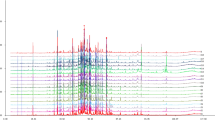Abstract
Agarwood is known to generate a distinct fragrance upon heating and is used as both a medicine and a fragrant wood. Low molecular weight aromatic compounds (LACs) such as benzylacetone are emitted from agarwood on heating and have a sedative effect on mice. These are detected exclusively in the headspace vapor of heated agarwood and are absent in the wood itself; hence, some compounds in agarwood are thought to be converted to LACs by the process of heating. In this study, different fractions obtained from agarwood were analyzed to reveal the source compounds of LACs. Some LACs detected in the resinous agarwood were absent from the non-resinous parts and confirmed as characteristic of the resinous parts. The essential oil and hydrosol of agarwood obtained by distillation were analyzed by gas chromatography–mass spectrometry (GC–MS). Sesquiterpenes were detected in the essential oil, and sesquiterpenes and a variety of LACs were detected in the hydrosol. A hot water extract of agarwood remaining in the distillation flask after distillation was analyzed by high-performance liquid chromatography (HPLC), and agarotetrol was found to be the main compound. Purified agarotetrol was heated in a glass vial and its headspace vapor was analyzed by solid-phase microextraction GC–MS. Benzylacetone and other LACs were detected. These results indicate that agarotetrol, a chromone derivative, contributes to the fragrance of agarwood through the generation of LACs upon heating.


Similar content being viewed by others
Change history
24 April 2019
In the original publication of the article, under the paragraphs ���Collection of volatile compound��� and ���Analysis of essential oil and hydrosol��� holding time for the end of GC and GC���MS programs at 180����C was incorrectly published as ���10��min���. The correct time limit is ���30��min���.
References
ANNUAL REPORT OF THE SECRETARIAT 2004, Convention on International Trade in Endangered Species of Wild Fauna and Flora, Appendices II
Takemoto H, Ito M, Shiraki T, Yagura T, Honda G (2008) Sedative effects of vapor inhalation of agarwood oil and spikenard extract and identification of their active compounds. J Nat Med 62:41–46
Kishida K, Ito M (2009) Components of agarwood oils and their effects on spontaneous motor activity of mice. Shoyakugaku Zasshi 63(2):39–45
Neaf R (2011) The volatile and semi-volatile constituents of agarwood, the infected heartwood of Aquilaria species: a review. Flavor Fragr J 26:73–89
Ishihara M, Tsuneya T (1993) Compounds of the agarwood smoke on heating. J Essent Oil Res 5:419–423
Miyoshi T, Ito M, Kitayama T, Isomari S, Yamashita F (2013) Sedative effects of inhaled benzylacetone and structual features contributing to its activity. Biol Pharm Bull 36(9):1474–1481
Takakuwa T, Shimizu M, Kubo K, Takeuchi F, Nishio S (1977) Koseikagakukenkyuhokoku, Showa 52 nendo, 92
Hashimoto K, Nakahara S, Inoue T, Shimada Y, Takahashi M (1985) A new chromone from agarwood and pyrolysis products of chromone derivatives. Chem Pharm Bull 33(11):5088–5091
Zambonin CG, Balest L, De Benedetto GE, Palmisano F (2005) Solid-phase microextraction-gas chromatography mass spectrometry and multivariate analysis for the characterization of roasted coffees. Talanta 66:261–265
Łucejko JJ, Modugno F, Ribechini E, Del Río JC (2009) Characterisation of archaeological waterlogged wood by pyrolytic and mass spectrometric techniques. Anal Chim Acta 654:26–34
Shimada Y, Konishi T, Kiyosawa S, Nishi M, Miyahara K, Kawasaki T (1986) Studies on the agarwood (Jinko). IV. Structures of 2-(2-phenylethyl)chromone derivatives, agarotetrol and isoagarotetrol. Chem Pharm Bull 34(7):2766–2773
Yoshii E, Koizumi T, Oribe T (1978) The structure of agarotetrol, a novel highly oxygenated chromone from agarwood (Jinko). Tetrahedron Lett 41:3921–3924
Konishi T, Okutani Y, Iwagoe K, Kiyosawa S, Shimada Y (1989) Studies of the agarwood “Jinko” (IX)1) quantitative analysis of 2-(2-phenylethyl)chromone derivatives (Supplement). Shoyakugaku Zasshi 43(1):1–6
Li J, Chen D, Jiang Y, Zhang Q, Zhang L, Tu PF (2013) Identification and quantification of 5,6,7,8-tetrahydro-2-(2-phenylethyl)chromones in Chinese eaglewood by HPLC with diode array detection and MS. J Sep Sci 36:3733–3740
Uchino S, Takahashi S, Oguri N, Maoka T, Kozuka M, Shimada Y, Hashimoto K (1998) Compositional analysis of the fragrance gas from agarwood by using curie-point pyrolysis-GC/MS and comnustion-GC/MS. Chromatography 19:3
Yagura T, Shibayama N, Ito M, Kiuchi F, Honda G (2005) Three novel diepoxy tetrahydrochromones from agarwood artificially produced by intentional wounding. Tetrahedron Lett 46:4395–4398
Okudera Y, Ito M (2009) Production of agarwood fragrant constituents in Aquilaria calli and cell suspension cultures. Plant Biotechnol 26:307–315
Author information
Authors and Affiliations
Corresponding author
Rights and permissions
About this article
Cite this article
Takamatsu, S., Ito, M. Agarotetrol: a source compound for low molecular weight aromatic compounds from agarwood heating. J Nat Med 72, 537–541 (2018). https://doi.org/10.1007/s11418-018-1185-y
Received:
Accepted:
Published:
Issue Date:
DOI: https://doi.org/10.1007/s11418-018-1185-y




